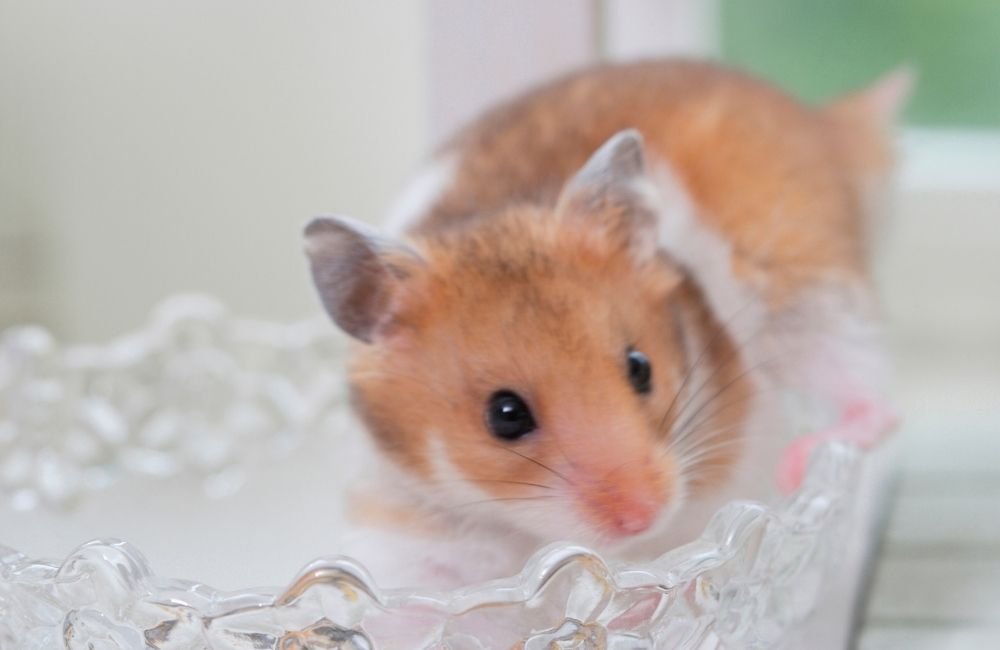Can Hamsters Swim? (Do They Like It?)
Maybe you have seen the numerous videos of hamsters swimming or heard that hamsters can indeed swim. Now you are thinking of checking whether your hamster can swim too or even teaching them how to.
Well, before you do that, read on to find out whether it’s really safe or not.
Hamsters can swim but they do not like it. This is because they are inclined to dry conditions in their natural habitats and do not like coming into contact with water. When they swim, they will do it as a means of survival, to try not to drown and die but not because they enjoy the activity. Water can make hamsters sick and remove the protective oils found on their coat leaving them looking dull.
How are hamsters able to swim?
Hamsters will swim by flapping around in the water looking for a way out. This can be entertaining as you may think that your pet is one skilled swimmer.
The truth though is that your pet will be swimming to save their lives. Their swimming action is a way of trying to get out of potential danger.
Naturally, hamsters are not skilled swimmers like other mammals. They don’t even come into contact with water in the wild unless they need some to drink.
What happens if a hamster swims
Sometimes hamsters will be put in bathtubs or swimming pools for a swim. This can be either as a way of exercising them or to take videos of them swimming.
However, there are some things that can arise when hamsters are made to swim. They include:
Drowning
Hamsters have small bodies and putting them in a large amount of water is very risky. They will use their small limps to paddle through the water and they can get exhausted fast.
This will make it easy for them to drown because they will get tired of flapping around which will make them go under the water. Drowning will make you lose your pet.
Dry coat
Hamsters should not come into contact with water because water is unsafe for them. Water strips their coats of natural oils which are essential for them.
Natural oils help in keeping their furs smooth and their bodies warm. When they are removed, the small pets will have a hard time keeping warm.
Their furs also become dry and rough which will make it hard for them to groom themselves properly too. If your pet swims in water that has chemicals, like in a swimming pool, their skin will get irritated by the contact.
Sickness

Water makes hamsters cold and this could bring diseases to them. If your hamster gets too cold they can develop hypothermia which is fatal.
They could also contract a cold or pneumonia both of which are fatal too if not treated fast enough.
Stress
Hamsters do not naturally like water because they are used to living in desert regions. So putting a hamster in water will make them scared and put them in distress.
As we’ve seen, they will try to swim in order to save their lives and that will not be an enjoyable experience for them. The fear of death will make them stressed.
Stress lowers a hammy’s immunity levels making them prone to diseases.
Stress can also bring about a serious condition called wet tail which is fatal. And generally, a stressed pet will be an unhappy pet which is not what you want for your smallest family member.
Measures to take if your hamster comes into contact with water
Whether you took your hamster for a swim, or you bathed them in water, or maybe they accidentally got into contact with water, you should take action immediately. Acting fast will save your pet from the effects of water.
First, take away the small animal from the water source. Then, use a soft dry towel to wipe out the water from their fur.
If the towel becomes too wet take another one and dry them up with it. You can use a blow dryer to dry the fur but make sure that it’s set to low.
Pick up your dried hammy and place them back in their cage. Make sure the cage is warm.
Keep a keen eye on them for signs of illness. If they begin showing symptoms like sneezing, wheezing, mucous discharge from eyes and nose, shivering, or inactivity, then you will need to see a vet.
How do you keep a hamster clean if they should not touch water
Hamsters are very clean creatures and they will groom themselves often making it unnecessary for you to clean them up. However, there may be some instances where they get a little too dirty and they are unable to tidy themselves as usual.
In times like this, your intervention will be required. Because you cannot dip them in water for a cleanse, you should instead invest in some good sand for the job.
Sand baths are the recommended baths for hamsters. Not only are they safe but also cheap and enjoyable for them.
Hamsters in the wild would normally use sand to bathe. Sand has a coarse texture that can easily scrub off matter stuck on their fur and help them get rid of any odors they may be having.
Ensure that the sand is safe with no harmful additions. Hamster sand, Chinchilla sand, and children’s play sand are some of the safe varieties to use.
You should also keep their cage clean at all times. Spot cleaning daily is very necessary.
Because hamsters will usually use only one area for their toileting, this makes it easier to tidy up. Instead of removing everything, take out only the soiled part of the bedding and replace it with dry one.
Full cleaning can be done weekly. A clean living area ensures that your pet doesn’t get their fur soiled by waste in the cage therefore keeping them tidy.
Swimming alternatives for hamsters
Hamsters are very active small animals that have a lot of energy. They will play around in their cage trying to use up this energy.
If it’s pent up inside them, they could become destructive and frustrated. They may start biting on cage bars, running around restlessly, or climbing all over.
To prevent this, regular exercise is required for your pet. Swimming can be a fun and relaxing exercise for humans, but it is a harmful exercise for them.
This is why you should indulge your pet in alternative exercises instead of swimming. Some good ones are:
Creating tunnels in their cages
Hamsters love burrowing and they usually burrow a lot in the wild. They dig up intricate tunnels underground to build burrows that they will use for various reasons.
Burrows act as their stores for food, hiding places, mating areas, and some will be for use during bathroom breaks. They create a different burrow for a different purpose.
You can help recreate this natural lifestyle by building them tunnels in their cages. Some cages come ready with in-built tunnels which is great.
However, if your pet’s cage does not have tunnels, you can easily make them yourself. Use something as simple as empty toilet paper rolls in addition to their bedding.
Pick a side of their cage where you will place the toilet paper rolls creating a tunnel then put bedding on top leaving an entrance for your pet. You can make it fun by hiding treats in the tunnels for them.
Hamster balls
Hamsters love running around in their balls. It’s an excellent way for your pet to explore your home while safely enclosed in a ball.
Ensure that you close the lid well before letting your pet roll around because they could fall out and get hurt. Avoid staircases or raised areas and do not let them out of sight.
Your pet can exercise with the ball for at most 30 minutes after which you should take them out. If they stay long they can get really hungry or dehydrated.
They may even poop or pee in the ball so always wash it up after use to prevent bacteria buildup that can cause infections to your pet.
Exercise wheels
Wheels can be bought independently or come with a stand in the cage. Hamsters enjoy running in wheels and can run for 6 miles a night.
Provide your pet with a wheel if they do not have one but only give them one with a constant surface because wheels with bars can trap their feet.
Conclusion
Hamsters can swim but they do not like it. Making your hamster swim will only cause them fear, stress, a dry coat, can lead to drowning and fatalities or even bring them illnesses like pneumonia.
Instead of forcing them to swim, indulge your hamster in fun activities that they enjoy like running in an exercise wheel, using a hamster ball, and playing around tunnels.
- Can Hamsters Travel in a Car? (Read This First)
- Why Do Hamsters Put Food in Their Cheeks? (Explained!)
- Can Hamsters Live Outside? (What You Should Know)
- Can Hamsters Learn Their Name? (Know The Details)
- Can Hamsters Eat Ice Cream? (Read This First)







